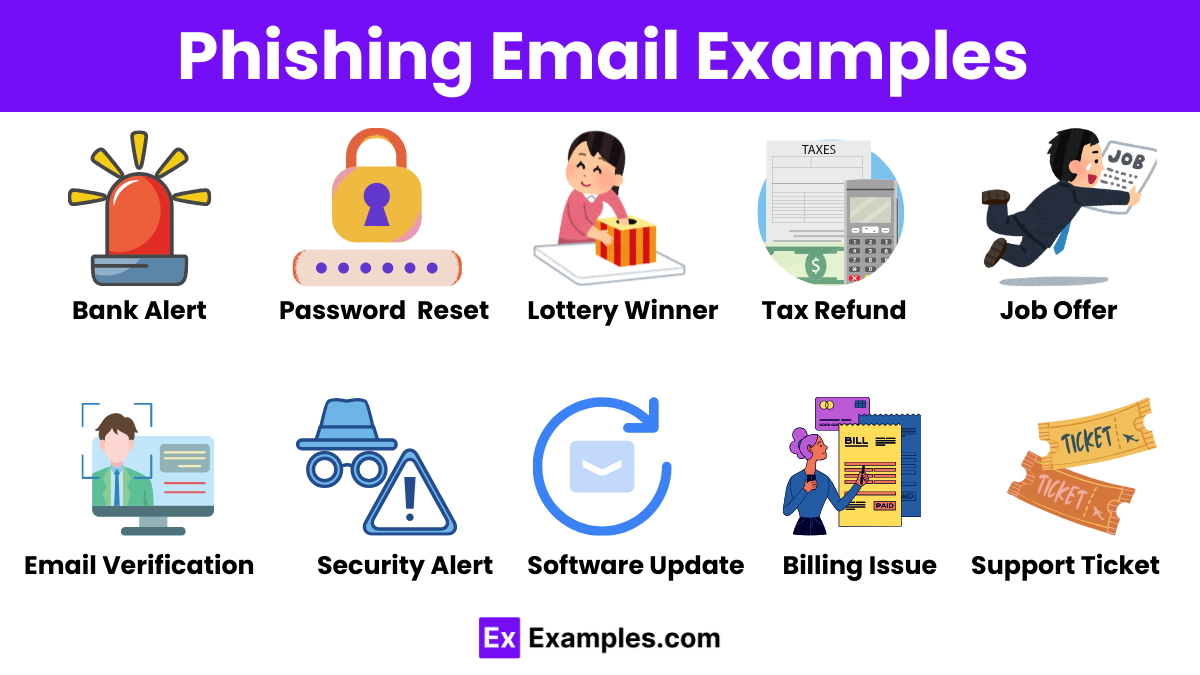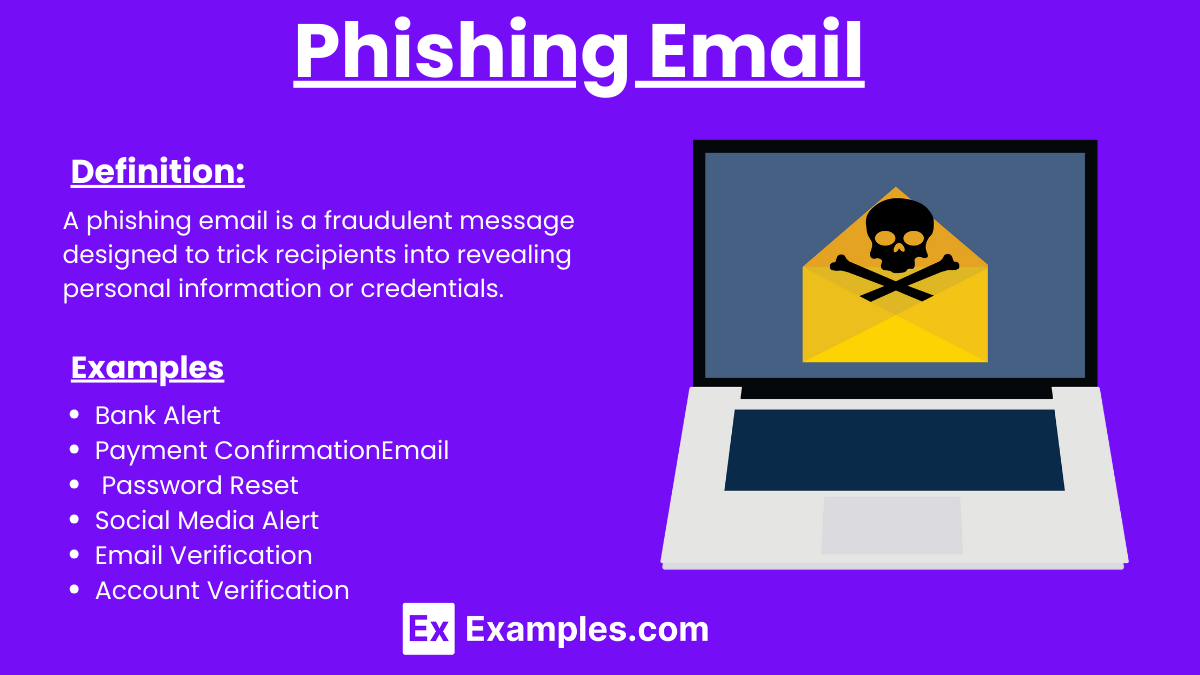36+ Phishing Email Examples to Download
Phishing emails are deceptive messages designed to trick recipients into revealing sensitive information, such as passwords or financial details. These emails often appear legitimate, mimicking reputable organizations. As a significant threat in cyber security, phishing can lead to severe data breaches and financial loss. This cyber security incident report highlights the methods used in phishing attacks, common indicators of such emails, and essential prevention strategies to safeguard against these fraudulent activities.
What is Phishing Email?
A phishing email is a fraudulent message designed to trick recipients into disclosing sensitive information, such as passwords or financial details. An investigation report outlines how phishing emails mimic legitimate sources to deceive users, leading to potential data breaches and financial losses.
Phishing Email Examples

- Bank Alert: “Your account has been compromised. Click here to verify your identity.”
- Account Update: “Your account needs updating. Log in immediately to avoid suspension.”
- Payment Confirmation: “Thank you for your payment. Please review the transaction details here.”
- Password Reset: “You requested a password reset. Click here to change your password.”
- Unusual Activity: “We detected unusual activity in your account. Verify your information now.”
- Invoice Attached: “Please find the attached invoice for your recent purchase.”
- Lottery Winner: “Congratulations! You have won a lottery. Claim your prize here.”
- Tax Refund: “You are eligible for a tax refund. Submit your information to process the refund.”
- Job Offer: “We have reviewed your application. Click here to complete your employment form.”
- Social Media Alert: “Your account is at risk. Secure your account by logging in here.”
- Charity Donation: “Support our cause. Donate now by following this link.”
- Email Verification: “Please verify your email address by clicking this link.”
- Security Alert: “Your account has been locked due to suspicious activity. Verify now.”
- Shipping Notification: “Your package is delayed. Track your shipment here.”
- Subscription Renewal: “Your subscription is about to expire. Renew now to continue service.”
- Software Update: “Update your software to the latest version by clicking here.”
- Conference Invitation: “Join our upcoming conference. Register here for more details.”
- Social Media Friend Request: “You have a new friend request. View profile here.”
- Credit Card Offer: “You are pre-approved for a credit card. Apply now.”
- Free Gift Card: “Claim your free gift card by completing this survey.”
- Account Verification: “Verify your account information to continue using our service.”
- Survey Participation: “Participate in our survey and win a prize. Click here to start.”
- Unauthorized Login Attempt: “An unauthorized login attempt was detected. Secure your account now.”
- Billing Issue: “There is a problem with your billing information. Update it here.”
- Support Ticket: “Your support ticket has been resolved. View the details here.”
- Purchase Confirmation: “Confirm your recent purchase by clicking this link.”
- Membership Upgrade: “Upgrade your membership to enjoy more benefits. Click here to upgrade.”
Phishing Examples In real Life
- Bank Login Phishing: “Your bank account has been locked due to suspicious activity. Click here to verify your identity and restore access.”
- PayPal Account Update: “Your PayPal account requires immediate attention. Log in here to resolve the issue and prevent account suspension.”
- Apple ID Alert: “Your Apple ID has been locked for security reasons. Click here to unlock your account and secure your information.”
- Amazon Order Issue: “There was a problem with your recent order. Click here to review and confirm your order details.”
- Netflix Payment Failure: “We couldn’t process your payment for the current billing cycle. Update your billing information to avoid service interruption.”
- IRS Tax Refund Notice: “You are eligible for a tax refund. Submit your details here to process the refund.”
- Microsoft Account Security: “We detected unusual activity in your Microsoft account. Verify your account here to prevent unauthorized access.”
- Google Account Security Alert: “A sign-in attempt was blocked. Review your recent activity and secure your account here.”
- Dropbox Shared Document: “A file has been shared with you via Dropbox. Click here to view and download the document.”
- Facebook Security Warning: “Your Facebook account was accessed from an unfamiliar location. Secure your account now by clicking here.
Tools to Help Protect Against Phishing
- Guardz: A cloud-based platform offering email scanning, malware detection, and automated responses for Microsoft 365 and Google Workspace.
- Trustifi: Provides email encryption, malware detection, and data loss prevention with AI-driven protection.
- Avanan: Cloud-based email security solution with advanced detection and prevention capabilities, including a quarantine mailbox.
- Abnormal Security: Uses AI to detect and neutralize sophisticated email-based threats, including spear phishing.
- Agari: Specializes in email authentication and threat detection to prevent email fraud and data breaches.
- Barracuda Sentinel: Utilizes machine learning and AI to protect against email-based threats like phishing and Business Email Compromise (BEC).
- Mimecast: Offers comprehensive email security solutions, including phishing detection and malicious link removal.
- Cofense: Provides phishing detection and response tools, along with employee training and awareness programs.
- Proofpoint: Delivers robust email security with advanced threat protection and compliance solutions.
- PhishMe (by Cofense): Focuses on phishing simulation and employee training to enhance organizational resilience against phishing attacks.
Phishing Email Analysis
- Phishing Identification: Detects fake emails mimicking trusted sources to steal sensitive information, commonly found in credit report scams.
- Indicators: Look for suspicious links, unexpected attachments, and urgent language.
- Impact: Leads to data breaches, financial loss, and identity theft.
- Prevention: Use email security tools, employee training, and multi-factor authentication.
- Response: In an essay on cyber crime, report and delete suspected phishing emails immediately to prevent further breaches and protect sensitive information..
7 ways to spot phishing email
- Suspicious Sender: Check if the sender’s email address is legitimate and matches the organization’s domain.
- Generic Greetings: Be cautious of emails that use generic greetings like “Dear Customer” instead of your name.
- Urgent Language: Watch for urgent or threatening language that pressures you to act quickly.
- Grammatical Errors: Look for spelling and grammar mistakes, which are common in phishing emails.
- Unusual Links: Hover over links to see if the URL matches the purported destination; avoid clicking on suspicious links.
- Unexpected Attachments: Do not open attachments you weren’t expecting, as they may contain malware.
- Personal Information Requests: Be wary of emails asking for personal information or passwords.
Spam email example text
Subject: Urgent: Your Account Has Been Suspended!
Dear Customer,
Your account has been temporarily suspended due to suspicious activity. Verify your information by clicking the link below:
If not verified within 24 hours, your account will be permanently suspended. Apologies for any inconvenience.
Best Regards, The Support Team
How To Identify Phishing Emails
Check the Sender’s Email Address : Verify the sender’s email address for legitimacy in email communication. Look for slight misspellings or unusual domains that mimic real organizations.
Look for Generic Greetings : Be cautious of emails that use generic greetings like “Dear Customer” instead of your actual name, indicating a mass email.
Analyze the Language and Grammar : Phishing emails often contain spelling and grammar mistakes. Look for awkward phrasing and urgent language prompting immediate action.
Inspect Links Carefully : Hover over links without clicking to see the actual URL. Ensure it matches the claimed destination and doesn’t contain suspicious characters or domains.
Be Wary of Unexpected Attachments : In an informative speech on cybersecurity, emphasize the importance of not opening attachments you weren’t expecting, especially if the email content seems suspicious or unverified, as they may contain malware.
How To Prevent Phishing Emails
Use Email Filters : Implement spam and phishing filters in your email system to automatically detect and block malicious emails.
Enable Multi-Factor Authentication (MFA) : Add an extra layer of security to your email subject lines by requiring additional verification steps beyond just a password to access accounts..
Educate Employees and Users : Conduct regular training sessions to teach individuals how to recognize phishing attempts and follow best practices for email security.
Install Security Software : Use comprehensive security solutions that include anti-phishing, anti-malware, and antivirus protections.
Regularly Update Software : Keep all software, including email clients and security tools, up to date to protect against vulnerabilities that phishing attacks may exploit.
Verify Suspicious Emails : Encourage users to verify unexpected or suspicious emails by contacting the sender through official channels rather than responding directly.
Use Email Authentication Protocols : Implement protocols like SPF, DKIM, and DMARC to authenticate emails and reduce the likelihood of fraudulent messages reaching inboxes.
What is a phishing scam?
A phishing scam is any fraudulent attempt to obtain sensitive information or money by disguising oneself as a trustworthy entity in electronic communications.
How can I identify a phishing email?
Look for generic greetings, spelling and grammar errors, suspicious links, and requests for personal information. Verify the sender’s email address and inspect unexpected attachments.
How can I protect myself from phishing emails?
Use email filters, enable multi-factor authentication, educate yourself about phishing, and verify suspicious emails before responding.
What is email spoofing in phishing?
Email spoofing is when attackers disguise an email to look like it comes from a legitimate source, often used in phishing attacks to gain the recipient’s trust.
Can phishing emails target businesses?
Yes, businesses are often targeted by phishing emails to gain access to sensitive corporate information or financial accounts.
What is a phishing link?
A phishing link is a URL in a phishing email that directs the recipient to a fake website designed to steal their information.
Can phishing emails infect my computer?
Yes, phishing emails can contain malware or links to malicious websites that can infect your computer when clicked.
Are phishing scams only limited to emails?
No, phishing can also occur through text messages (smishing), phone calls (vishing), and social media.
What is spear phishing?
Spear phishing is a targeted phishing attack directed at specific individuals or organizations, often using personalized information to appear more convincing.
Are there legal consequences for phishing?
Yes, phishing is illegal and perpetrators can face severe penalties, including fines and imprisonment, under various cybercrime laws.


